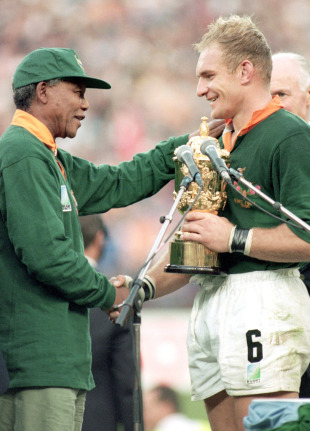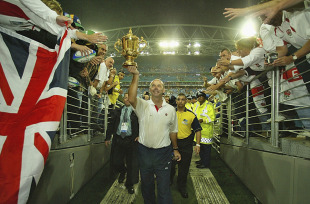|
Rugby World Cup Countdown
Life through a lens
Graham Jenkins
January 21, 2011

Rogers witnessed this magic moment in the sport's history between South African President Nelson Mandela and Springboks skipper Francois Pienaar
© Getty Images
Enlarge
President Mandela and Springboks captain Francois Pienaar uniting a nation, Jonny Wilkinson's dramatic drop goal, All Black giant Jonah Lomu trampling over Mike Catt - the Rugby World Cup has provided plenty of indelible images over the years and chances are that your memory of these events and many others have been shaped by the lens of veteran sports photographer Dave Rogers. The 54-year-old Englishman witnessed first-hand the growth of rugby's showpiece event into one of the greatest sporting shows on earth and has had a front row seat for some of the defining moments of the modern era. Many blessed to occupy such a position would perhaps dream of swapping places with the game's leading protagonists - but not Rogers. "I've never played a game of rugby in my life," he told ESPNscrum in a rare break from his rugby travels. "I was once picked to play for the Rugby Union Writers' Club team but I turned up ten minutes after kick off by which time the guy who had replaced me had gone off injured having busted three ribs and two fingers - and I thought 'that could have been me!'" Rogers is one of the lucky few to have been able to build a career around his passions - sport and photography. "I had always been mad keen on sport and had thought photography would be a fantastic thing to do," he said. "For my sins I am a Wolves fan and I used to go there all the time and look at these snappers taking photographs and fancied having a go at it myself. "I was an accountant for a week and hated it and resigned on a Friday with no other job to go to. But the following morning a letter arrived asking if I could start college the following Monday. I think that's what they call destiny." His hobby became his living soon after, with four years at the Birmingham News & Mail Group followed by 15 years at Bob Thomas Sports Photography, where Rogers would make his name as one of the best in the business. "I think my first rugby match for Bob was at Twickenham in '79," he recalled. "He then said he was going to send me on the Lions tour to South Africa in 1980 which was massive for me. That trip was incredible and I loved everything about it - the people, the players and the other journalists. From that point in my life rugby became a great love of mine." Rogers is part of an exclusive club, having worked at every Rugby World Cup during his 32 years on rugby's front line, and has seen the tournament blossom in terms of its staging and its impact on the sporting landscape. "The World Cup was tiny back in '87 and almost amateurish," he said. "One of the semi-finals was staged at the [20,000 capacity] Concorde Oval in Sydney which is so small and to think that a semi-final was played there only a few years ago is amazing." Rogers covered the first two World Cups for Bob Thomas but by the time of the third tournament he had joined Allsport, a company that would later be acquired by Getty Images - his current employer. The 1995 gathering of the sport's elite is widely acknowledged as a defining moment in the sport's history and Rogers revealed it has also had a lasting impact on him.
"I get very emotional even now when I think about it," he said. "It was amazing and it meant a lot to me as I am fond of South Africa and the people. I had been over there in the Apartheid days working on a book with the Sunday Times' John Hopkins during which time we met Desmond Tutu, went into townships and got chased by the police. So we knew the sort of hell some people were living in back then. And to go again when the whole nation was behind the team was incredible. Chester Williams was the hero of the people and that moment when Nelson Mandela presented the trophy to Francois Pienaar was wonderful." Rogers was there to record that moment and was well-placed again in 2003 when Wilkinson struck the decisive blow in the most dramatic World Cup final. "I've never been as nervous as I was in those last few minutes when Jonny was lining up for the drop goal," he said. "I was not nervous for them but for me in case I missed it. In the end I was lucky that he kicked it with his right boot because if he had been facing the other way I would have got a great shot of his backside." The many years Rogers has been in the thick of the action have seen him cultivate relationships with many of sport's leading figures. He cites Diego Maradona as one of his favourite subjects and once received a Christmas card from the legendary Argentinean footballer, although it was "ripped up" in the wake of his infamous 'Hand of God' goal against England at the 1986 World Cup. There was a greater sense of trust with Clive Woodward and his players in the lead up to their 2003 World Cup triumph and as a result Rogers was invited to share in their glory. "It would have to be the highlight of my career," he said. "To be an Englishman in the dressing room after that game with the players and the Royals was fantastic and something really special. The atmosphere that had built up around that team was great and in a way you feel part of it. You are as close as anyone outside the team can be and I'm closer than the journalists as I get such great access that they never do. It's very relaxed but I don't over-step the mark, I'm still a media guy." As the central figures on such special days have changed so has the way Rogers has recorded and sent their images around the world. The World Cup is not the only thing to have experienced explosive growth over the years, with the technology available now simply light years from his experiences in the early part of his career.

The image of England coach Clive Woodward parading the World Cup in 2003 is amongst Rogers' favourites
© Getty Images
Enlarge
"When I first started you would do a game on a Saturday then go back to your hotel room and black out all the windows to make it into a dark room," he explained. "You'd print to 10x8s in black and white and then take them to the main post office in whatever town you were and they would then send it off to off to Cable & Wireless in London on a big machine called a Muirhead which was the size of a grand piano. My old boss Bob Thomas would then drive to London to pick up the negatives and take them home to develop before returning the photos to Fleet Street for the Monday papers. "Today we take the pictures and download them to our laptops pitchside before editors in the stand send them around the world. But we probably only switched to digital about five or six years ago." Getty Images will launch their assault on this year's World Cup with a squad to rival that of any of the competing teams in terms of numbers. "We will aim to have a minimum of three photographers for every game and then on top of that we have editors and technicians in case the system breaks down," he said. "The World Cup has just got bigger and bigger over the years but I fear this year's tournament may struggle to do that. New Zealand is a great place and the people are friendly but the stadiums simply aren't as big." With such a sixth sense for being in the right place at the right time it appears that only one thing could stop Rogers adding to his impressive portfolio later this year and that is the New Zealand government. "I got my gear impounded in New Zealand recently because I didn't have a carnet [customs document]," he exclaimed. "I've never had one in my life and I've been doing this since 1978!" Rest assured he will have the right paperwork come September as he carves out a few more memories for us all. © ESPN Sports Media Ltd. Graham Jenkins is the Senior Editor of ESPNscrum.
| |||||||||||||||
Live Sports
Communication error please reload the page.
-
Football
-
Cricket
-
Rugby
-
- Days
- Hrs
- Mins
- Secs
F1 - Abu Dhabi GP
Abu Dhabi Grand Prix December 11-131. Max Verstappen ()
2. Valtteri Bottas (Mercedes)
3. Lewis Hamilton (Mercedes)
4. Alexander Albon ()
5. Lando Norris ()
6. Carlos Sainz Jr ()
-
ESPNOtherLive >>
Boxing - Nelson v Wilson; Simmons v Dickinson; Joshua v Gavern (Metro Radio Arena, Newcastle)
Golf - Houston Open
Snooker - China Open
Tennis - Miami Open

